HonestReporting employs an array of tools to respond quickly to inaccurate or biased news articles. Our weekly communiques identify and challenge the worst cases of bias, and our 24HR Megaphone tool instantly alerts subscribers to issues that require immediate attention.
However, not all cases of slanted reporting are instantly clear. It’s often helpful to take a step back and examine a news organization over a long-term period. Subtle elements of bias such as headline or photo selection then become clearer. In our second in-depth media analysis, we studied six months of reporting from the New York Times, one of the most popular and influential newspapers in the world.

The New York Times: April-September 2007 – Summary of Findings:
- Balance: Despite an evenly balanced selection of stories on Israel and the Palestinians, the New York Times gave far more weight to Israeli military incidents in text location, headlines and photo selection than to Palestinian attacks. More than 60% of images sympathetic to one side or the other favored the Palestinians.
- Consistency: Israeli and Palestinian actions were not treated consistently in choice of language. Israel or the Israel Defense Forces were the subject of strongly worded, direct headlines in 18 out of 20 cases (90%). However, in the 20 cases where the Palestinians were responsible for attacks, the language was mostly passive and the group responsible was only named in eight instances (40%).
- Context and Accuracy: Inaccurate statements or important context that would give readers a fuller picture of news events was often omitted. Terms such as “militants”, “occupied territory,” and “illegal settlements” were used without providing a proper explanation.
Findings in Depth:
I. BALANCE:
An important indicator of bias, balance means the news source gave equal weight to conflicting claims over a period of time. Both subject matter and style are important factors in weighing bias.
During the time period under review (April 1 through September 30, 2007), we analyzed a total of 121 articles whose dominant focus dealt with Israel or the Palestinians, including 40 that focused on a violent attack or military action by Palestinian terrorist groups or the IDF. Some described events between Israel and Palestinian groups and others described internal Palestinian fighting. We found that reporting favored the Palestinian side through both text priority and selection of images.
Text Priority:
In articles that reported on violent actions, Israeli moves were almost always reported first, regardless of whether they occurred prior to or in response to a Palestinian attack. Only later — lower down in the article — was there mention of the cause of the Israeli action. By placing accounts of Israeli military actions before those of Palestinian attacks, the Israeli actions seem to lack justification.
For example, the article “8 Israeli Airstrikes in Gaza Kill at Least 7” opens with this paragraph and photograph:
“Israel moved a small number of tanks and soldiers over the Gaza border and hit Hamas with eight airstrikes on Thursday and early Friday, killing at least seven Palestinians.”
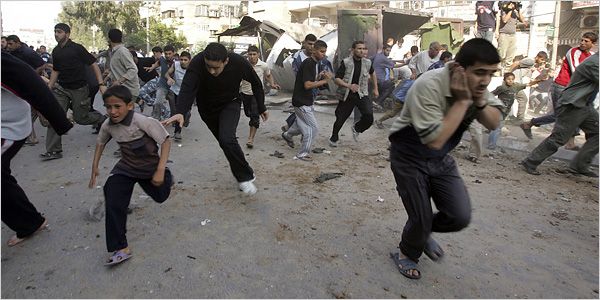
Only after this does the reader see:
“Some 14 rockets fired by Hamas militants in Gaza on Thursday landed in Israel, 6 of them near Sderot, a border town, the Israeli Army said. The government bused some Sderot residents to hotels in what it called a respite, not an evacuation.”
While the reporting is technically accurate, the fact that Hamas fired rockets at Israel is overshadowed by the description of the Israeli response. In fact, 20 out of 24 articles describing fighting between Israel and the Palestinians lead with the Israeli action, regardless of which action took place first. This style of reporting gives the reader the impression that the Israeli military attacks occurred much more frequently than the Palestinian ones. In truth, during this time period, there were weekly (and often daily) actions by both sides. Although Palestinian casualties were higher, the number of rocket attacks against Israel was far greater than Israeli responses. Proper balance would have made this clear.
Photographs:
Editors have many choices which photographs accompany news articles. We looked at the photographs that ran with the New York Times’ articles and found that there seemed to be an inappropriate and unbalanced emphasis on either Palestinian suffering or Israeli military operations. The Sometimes the photos which accompanied the articles did not even feature the primary content of the article. For example, on May 17, the Times published “Unity Fractures as Palestinians Battle in Gaza.” The primary thrust of the article described fighting between the Palestinian Hamas and Fatah organizations. Yet, the photo chosen to accompany the story showed an Israeli attack.
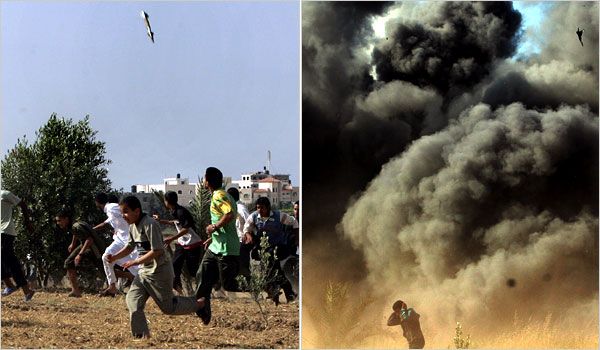
For our study, we focused on images that clearly favored one side or the other. Images of Palestinian suffering or Israeli attacks favor the Palestinian side. Images of Israeli suffering or masked Palestinian terrorists encourage understanding of the Israeli perspective. Of the images showing one point of view or the other, over 60% were pictures that evoke more understanding or sympathy for the Palestinian side. The viewer thus gets the impression that there are far more Israeli military strikes against Palestinian civilians than Palestinian rocket attacks.
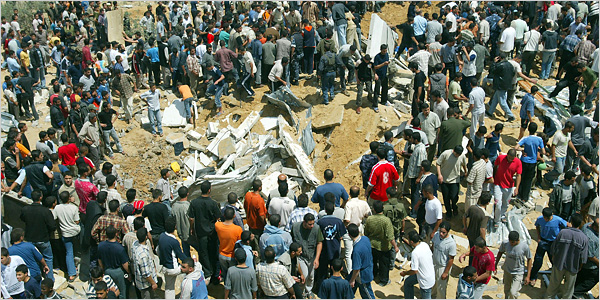
II. CONSISTENCY:
Style can have a significant impact on how news events are perceived. This is particularly important in headlines which set the tone of an article. Sometimes, people even skip reading the article and simply skim the headlines. Due to the impact of headlines, it is reasonable to assume that news organizations would adopt specific guidelines for consistency. However, we found serious inconsistencies with the style used by the Times.
A headline should be very clear and direct, leaving no confusion over who initiated an action and what that action was. For example, “Israeli Army Kills 3 in Gaza” is written in an active tense and identifies the subject of the action (“Israeli Army”) but leaves us wondering who were the recipients (“3” — were they civilians?) The article actually referred to an event in which three members of Hamas were killed while planting explosives along the border. Yet the editors chose the headline, emphasizing the Israeli Army and downplaying the nature of those who were killed. (An alternative headline could have been “Terrorists Die While Planting Bombs.” Such a headline would have focused attention on the terrorists and their actions.)
On the other hand, headlines referring to Palestinian attacks usually used a different style. For example, “Rocket Injures 40 Israeli Soldiers” is written in a more neutral style and leaves much out. The “rocket,” not the terrorist organization which launched it, is the subject of the sentence. From the headline, we do not know if anyone fired the rocket or if it went off accidentally. All we do know is that the victims were military personnel, not civilians. If the Times was consistent, it could have had a headline such as “Terror Group Fires Rocket Injuring 40 Israelis.”
These inconsistencies are subtle yet important. Were these isolated examples, one might be able to brush it off as unintended results of hasty editing. Yet we found this pattern occurring repeatedly. Even when the article concerns Palestinian infighting, we usually found passive sentences that fail to identify the aggressor. (“Clash at U.N.-Run Gaza School Wounds 6, “Palestinians in Border Fight: One Dead.”)
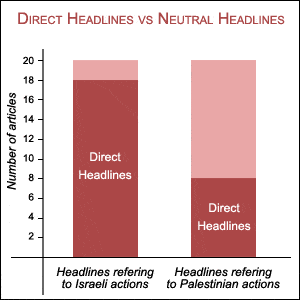
In twenty cases in which Israel initiated a military action, 18 headlines (90%) named Israel or the Israel Defense Forces in strongly worded, “direct” headlines. In 20 cases where the violence was initiated by Palestinians, only eight (40%) used a similar style.
III. ACCURACY AND CONTEXT
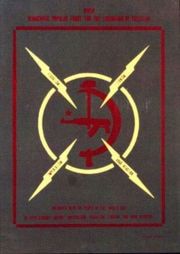
We looked at examples of articles that were less than accurate or lacked important context. For example, “Israel Fires on Militants Planting Bomb“, mentions that the “militant” planting the bomb was a member of the Democratic Front for the Liberation of Palestine. The only word used by the Times to describe the DFLP is “leftist.” In actuality, the DFLP is an extremely violent terror organization best known for attacks against schoolchildren. (The Ma’alot attack of 1974 and the Avivim school bus massacre of 1970 are but two examples.) Its own website lists numerous calls for violent attacks against Israel. Some more detail could have been included to let readers know that the man killed by the IDF was a member of a notorious terror group, not simply a “leftist.”
As noted earlier, a brief, misleading reference in an article can create inaccurate perceptions. “Invisible Palestinians Exist in Legal Limbo in Lebanon” is an account of Palestinians living in Lebanon who are not recognized by the United Nations as refugees. Many of them used to belong to the PLO and ended up in Lebanon when the PLO was expelled from Jordan. Here is how the article referred to their origins:
“Mr. Hamdallah did not flee when Israel was formed over the former Palestine in 1948, and so he and his family did not meet the United Nations definition of Palestinian refugees.”
Israel was not formed over the former “Palestine.” The way the article is worded lends credibility to those who argue, incorrectly, that Israel exists on “Palestinian” land, and that Israel took over a state called “Palestine” that existed beforehand.
The Times could also do a lot better job providing better explanations and context for complicated issues. Usage of terms such as “illegal settlements” and “occupied territory” need to note that there are many opinions which support the fact that the settlements are not “illegal” and that the territory is best referred to as “disputed” rather than “occupied.” (See “Over the Line” for an example). By using the language of one side of the conflict, the Times is overstepping it’s role to be an objective source of information.
Conclusions
As one of the most widely read and influential newspapers in the world, the New York Times has a special responsibility to ensure that its reporting is balanced, fair, and accurate. Yet in terms of balance, consistency and context, we found that the coverage is more sympathetic to the Palestinian cause. The New York Times should take steps to ensure that:
-
Total coverage of the Middle East is balanced, with Israeli and Palestinian actions treated more objectively;
-
The style used in writing headlines be consistent so as not to lend support to one side or the other; and
-
Articles be reviewed more carefully to promote accuracy and to ensure that complicated issues are placed in context.
HonestReporting subscribers can help push the New York Times to take these measure by writing to the Public Editor of the New York Times by clicking here ([email protected]).
We plan to continue publishing long term analyses of specific media to determine whether reporting is fair and consistent. You can read our previous analysis of the BBC by clicking here. If you are interested in sponsoring one of these reports, please click here.

